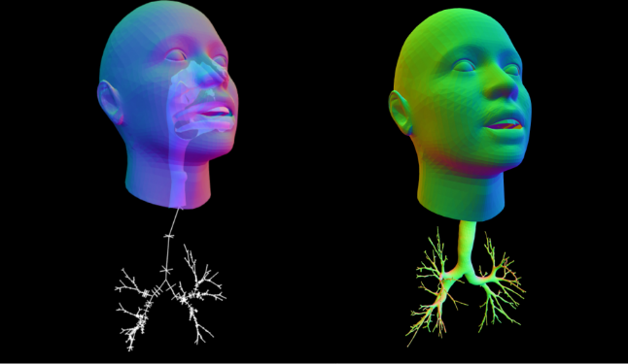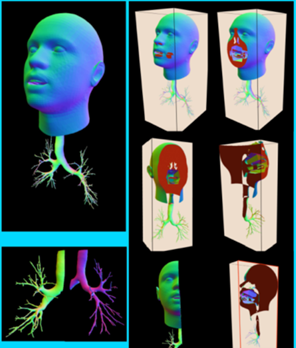EPA Releases Cutting-Edge Human Respiratory System Model

Published September 6, 2023
EPA scientists recently developed a new online tool that offers researchers, medical practitioners and others, a comprehensive model of the human respiratory system. EPA’s new Human Respiratory System Model is a 3-D model of the human respiratory system from the tip of the nose to the lower lung regions. The model is based on human scan data and can be adapted to account for age, ethnicity, height, weight, and sex.
The respiratory system model is an important advancement for investigating aerosolized contaminant transport, deposition, and clearance in the human respiratory system. The model is designed for public, private, academic, medical, and research applications.
“We created the model to be an easy-to-use, multifunctional tool to help medical professionals and researchers working on inhalation and respiratory issues,” said lead EPA researcher Jacky Rosati, Ph.D.
Uses and Application

The model’s user interface gives researchers and the broader health community simplified access to respiratory modeling and associated data. When users input specifics such as sex, age, and physical parameters into the interface, a surface model is generated that includes the nasal and oral cavities, pharynx, larynx, trachea, and three airway paths. This specialized surface model can be viewed in a web browser or exported and saved as a standard stereolithography (STL) computer-aided design (CAD) file, that can then be used with other computer applications. The model can be used with Google Chrome, Microsoft Edge, Mozilla Firefox, and other compatible modern browsers.
The model interface allows users to modify internal face morphology to match external facial features, providing increased levels of model customization and accuracy. The model uses multiple sets of human data to ensure results are representative of the general population. It also allows for nasal or mouth breathing with a physiologically accurate mouth, tongue, gums, and uvula, making it useful when assessing the impact of respiratory stimuli on specific populations.
The respiratory model can be used for a variety of purposes including:
- Determining exposure and dose from hazardous contaminants (e.g., anthrax, ricin) where inhalation studies on humans cannot be conducted.
- Visualizing respiratory flow from the tip of the nose to the lower lung regions.
- Investigating dosimetry and inhalation toxicology for general and sensitive populations such as the diseased and the elderly.
- Identifying best practices for respiratory drug delivery.
- Reducing animal and human use in experimental testing, thus reducing testing times as well as costs.
- Planning for oral/nasal/lung surgery.
- Providing educators with a free, customizable anatomical model of the human respiratory system for use in school settings.
Ongoing Research and Access
EPA researchers plan to continue developing the Human Respiratory System Model to ensure public access to the most updated data. In the coming years, researchers hope to incorporate additional items into the model that define human airways and impact breathing, deposition, and clearance patterns including morphological changes created by respiratory disease; dynamic physiologies to mimic anatomical changes of the respiratory system during a breathing cycle; mucociliary action; and the incorporation of functional alveoli. Once integrated, these items will allow for virtually any variation of airway geometries and disease states.
For more information, or to use the model, visit EPA’s Human Respiratory System Model website.
Learn More:
